subpage of iccf-21/videos/
[spacer height=”10px”]
Video link, slide PDF, abstract from pre-conference distribution.
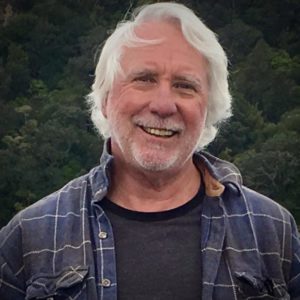
The Fleischmann-Pons heat and ancillary effects. What do we know, and why? How might we proceed?
#Michael C.H McKubre1
1SRI (Retired), New Zealand
Email: mmckubre@gmail.com
ABSTRACT
[spacer height=”10px”]
After almost 30 years of studying seemingly anomalous nuclear effects in metal hydride systems what can we say that we have learned with high-level confidence? For some of us it has been a nearly full-time journey; for a rare few nearly fully-funded. After this time and effort what is it that we can assert and defend about our new knowledge of nuclear reactions in condensed matter? These questions are subjective and I will focus my answers on what I have learned by direct experiment and analysis, and from the experience of a few close colleagues – mostly ENEA (Italy), Energetics (Israel), MIT and various Navy Labs around the US.
[spacer height=”10px”]
One must seek scientific truth via correlation. Isolated “facts” are rightly called “anomalies”. These are useful in alerting the world to the presence of potential novelty but are not particularly useful in themselves and I have resisted characterizing our field as “anomalous”. Anomalies exist to be explained or rejected – in either case forsaken as anomalies. At one point I recommended not accepting papers for presentation at one of our conferences unless more than one variable was measured and a correlation shown between them. In our work at SRI, initially the correlation sought was excess heat and loading. Under EPRI sponsorship (and gentle duress) we searched diligently for correlation between excess heat and any plausible nuclear product: neutrons, gammas, X-rays or low energy gammas, betas, photo-radiographic evidence of any photons, tritium (indirectly) and (finally) helium-4 and helium-3.
[spacer height=”10px”]
This exercise of seeking multi-correlation is, however, exquisitely painstaking and, therefore expensive, requiring the physical presence of experts covering a wide range of specialized knowledge and specialized hardware. In FPHE experiments more subtle difficulties are added by the challenge (or impossibility) of optimizing experiments to satisfy the constraints of: electrochemistry, without which there is insufficient loading and apparently no effect; calorimetry, without which there is no believable effect to correlate; and whichever of the pantheon of potential nuclear products (not ash) that one strives to correlate. Obviously everyone except the experimenter would prefer the search for products in all plausible output channels, in real time, and in situ. But this is experimentally not possible at our present level of investment – and perhaps not at all unless the effect is made larger and triggerable. Gozzi et al [1] have reported a nuclear multi-correlation (X-ray, heat excess and helium-4 in the D/Pd system) but they were cautious in their interpretation and this work was not continued.
[spacer height=”10px”]
How might we proceed rationally? Nearly 30 year old anomalies should have grown to adult maturity and self-sustainability or been buried and forgotten. By various factors we have been heavily constrained from pursuing and accomplishing the one thing that would make anomalies go away: correlation, preferably multi-correlation. Correlation is one thing that can rapidly advance our research and cause. Practical reality is another – a working device even if only a toy, but with net gain and easily observed utility. The search for correlation would be vastly simplified by an ability to trigger the effect on demand thus permitting phased analysis. A working device demands even more – the capability to control the effect; the ability to turn it on/off, up/down. What indications do we have to encourage us and guide us to tread either of these paths?
[spacer height=”10px”]
[1] D. Gozzi, P. L. Cignini, M. Tomellini, S. Frullani, F. Garibaldi, F. Ghio, M. Jodice and G. M. Urciuoli, Proc. ICCF2, p. 21 (1991).
[spacer height=”10px”]
[spacer height=”10px”]
Slide1
[spacer height=”10px”]
Slide1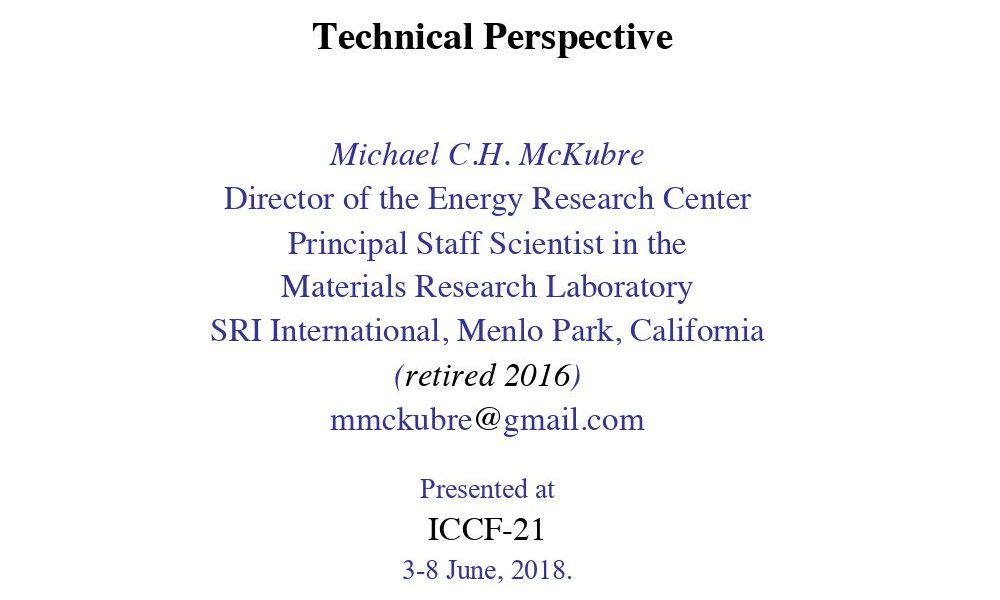
[spacer height=”10px”]
00:00 well good morning! it’s exactly 4 00:04 o’clock in the morning my time.
[spacer height=”10px”]
I will 00:07 attempt to hold your attention and mine. 00:11 the slides move by asking? next slide 00:16 please.
[spacer height=”10px”]
Slide2
[spacer height=”10px”]
00:29 it looks like that worked.
[spacer height=”10px”]
so, Dave 00:34 gave a fairly flowery and flattering 00:37 introduction. I just have a little list 00:42 of my background here I knew. . . . most of you 00:45 guys know me , I’ve been doing this a long 00:46 time. I’ve been doing cold fusion since 00:52 March 23rd,1989.
[spacer height=”10px”]
entered the field 00:56 mostly because I knew Martin.
[spacer height=”10px”]
I knew him 01:00 to be an extraordinarily inventive and 01:05 imaginative guy, and I think had it been 01:08 anybody except Martin I wouldn’t have 01:10 bothered to go into the laboratory.
[spacer height=”10px”]
the 01:12 idea was transparently ridiculous.
[spacer height=”10px”]
but he 01:17 was Martin.
[spacer height=”10px”]
I also had better 01:21 reasons to reject his claims, having 01:26 worked in the deuterium palladium system 01:28 for already a decade at that point.
[spacer height=”10px”]
so 01:30 I’d been exploring palladium in heavy 01:35 water for 10 years for an entirely 01:38 different purpose, and I thought I 01:39 understood the system, so in 1989 01:43 I understood. deuterium-palladium. got it.
[spacer height=”10px”]
01:47 nearly 30 years on, I know a lot less now 01:52 than I knew then.
[spacer height=”10px”]
my windows of 01:56 ignorance have opened wide.
[spacer height=”10px”]
until two 02:00 years ago, as Dave said my effort was 02:02 essentially full-time on this topic, 02:07 essentially fully funded, and at least 02:11 half of my focus for the 02:13 thirty years has been on cold fusion and 02:16 related matters.
[spacer height=”10px”]
I was sort of head down 02:19 buried in a trench, looking at this 02:25 world in a particular way, and, in a way, 02:27 retirement to New Zealand has given me 02:32 an opportunity for reflection.
[spacer height=”10px”]
so what 02:34 I’m doing, while I’m sitting on my deck 02:36 overlooking the ocean, drinking beer, is 02:39 thinking about what did I do?
[spacer height=”10px”]
you know, 02:43 what do I know?
[spacer height=”10px”]
what what have I been 02:45 saying to you, over the years which is 02:49 not actually completely true? 02:52 what things have I 02:54 convinced myself of, by repetition, that 02:57 aren’t quite as solid as I maintained 03:03 and believed, and so I covered a lot 03:07 of this yesterday [in the Short Course].
[spacer height=”10px”]
you know, a little bit 03:08 of retrenchment and retraction. I don’t 03:11 back off any of the big claims, but some 03:13 of the details need a little tweaking.
[spacer height=”10px”]
so 03:19 this reflection has done me some good. 03:24
[spacer height=”10px”]
I’m still learning to drive this tool [the slide control]
[spacer height=”10px”]
Slide3
[spacer height=”10px”]
03:27 there you go. just a reminder for those 03:32 that haven’t attended every one of these 03:34 conferences, the contributions that my 03:38 group — which is of which is a broad group, 03:40 I have a slide at the end which 03:44 acknowledges my important collaborations, 03:48 which has fifty nine people on it. 03:50 unfortunately, I think 13 of them no 03:53 longer with us, but it was a large group, 03:56 a large effort, a large focus on the 04:00 things that we knew very well at the 04:03 beginning. the loading diagnostic 04:05 resistance ratio was something that I’ve 04:07 been using as a tool since 1978, when I 04:13 arrived at SRI, so I was well poised to 04:16 use resistance methods to measure the 04:20 loading of deuterium into palladium.
[spacer height=”10px”]
I 04:22 have an electrochemistry background 04:24 specifically electrochemical kinetics, can 04:26 so I understood the tools and means 04:29 and tricks that one might need to employ 04:32 in order to push deuterium as hard as 04:35 possible into a palladium.
[spacer height=”10px”]
I had no 04:38 background in calorimetry, I had no intention 04:41 of having any background in calorimetry, or 04:44 desire, but if you’re looking for heat 04:47 and you’ve got to use calorimetry.
[spacer height=”10px”]
so we 04:49 basically taught ourselves calorimetry, 04:51 and pretty much dragged mass flow 04:55 calorimetry kicking and screaming into 04:58 the 20th century, and I mean 20th century.
[spacer height=”10px”]
05:04 we’ve done work on observation of 05:09 tritium, both directly as tritium and as 05:14 its decay product, helium-3, done a fair 05:18 amount of work with helium-4 05:20 measurements, and in the early days with 05:25 EPRI sponsorship, the charge was examine 05:31 all possible nuclear products 05:36 simultaneously.
[spacer height=”10px”]
. . . sounds scientifically 05:39 reasonable, but it is practically 05:41 impossible and hideously expensive, but 05:44 the biggest problem is: to optimize one 05:48 detection method, you always compromise 05:51 another.
[spacer height=”10px”]
so you have to be quite 05:53 selective in what it is you set out to 05:56 measure.
[spacer height=”10px”]
but every one of the experiments 05:58 we did was continuously monitored for 06:01 neutrons, for radiation health 06:04 purposes, and gammas and other things.
[spacer height=”10px”]
so 06:07 we’ve done a lot. that actually has 06:09 nothing to do with my talk I just wanted 06:10 to, you know, boast a little.
[spacer height=”10px”]
Slide4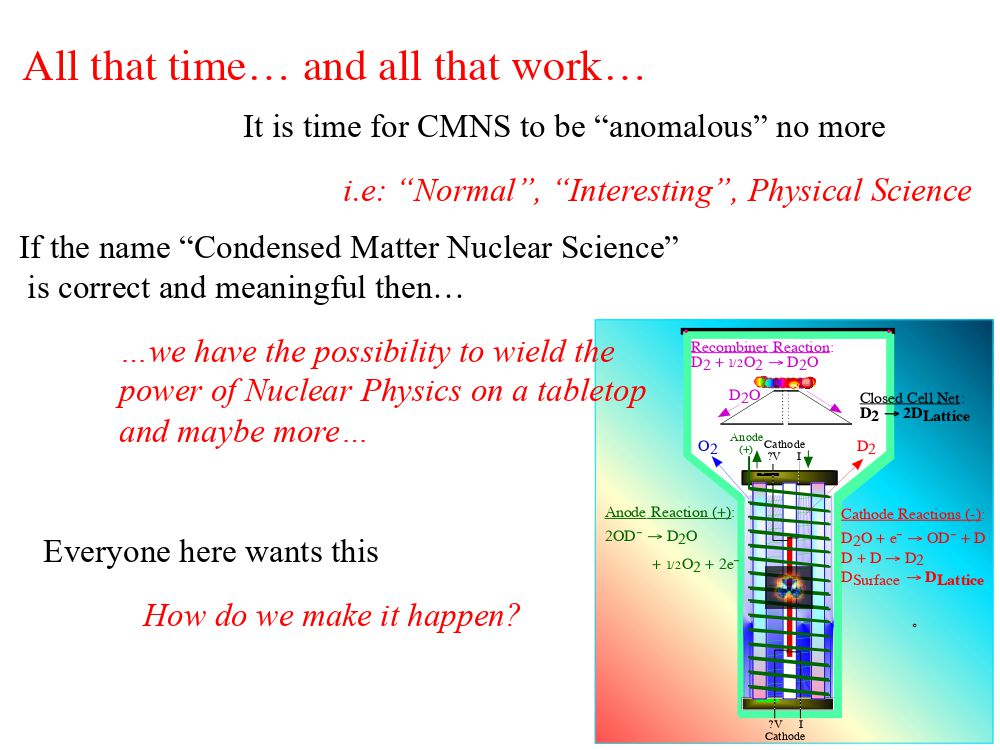
[spacer height=”10px”]
so all that 06:15 time, and all that work. . . . I think it’s time 06:18 for condensed matter nuclear science, 06:22 cold fusion, to be anomalous no more. I 06:26 want it to be normal, 06:28 interesting, physical science. I don’t 06:30 want to curb and hold my tongue in 06:38 meetings of learned physicists.
[spacer height=”10px”]
I want 06:42 them to engage in dialogue, and until 06:47 such time as we can engage in free and 06:51 open dialogue, with the broader 06:53 scientific community, I don’t think we’re 06:54 going to make very much progress.
[spacer height=”10px”]
but if 06:59 the name of condensed matter nuclear 07:01 science is accurate and meaningful, we 07:05 have the possibility to wield the power 07:07 of nuclear physics on a tabletop.
[spacer height=”10px”]
heat is 07:12 a poor product. it’s the worst product.
[spacer height=”10px”]
07:15 what else might one be able to do if one 07:18 can wield some — or more — of the power 07:23 of nuclear physics, directly under your 07:26 control, in a tabletop 07:30 experiment.
[spacer height=”10px”]
everyone here wants this to 07:34 happen. 07:35 you’ve self selected.
[spacer height=”10px”]
the reason you’re 07:37 in this room is you’re curious, and 07:39 you’re curious because you would like it 07:41 to happen.
[spacer height=”10px”]
Slide5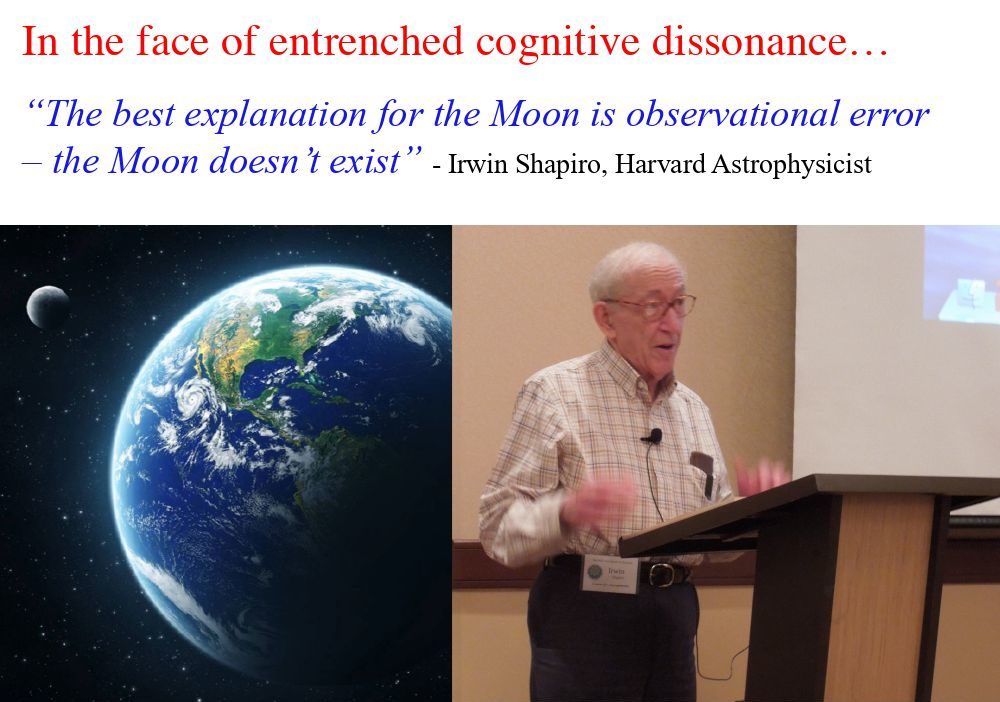
[spacer height=”10px”]
okay, in the face of cognitive 07:47 dissonance, and Tom spoke some about this, 07:51 I love this quote from Irwin 07:55 Shapiro. he’s a Harvard astrophysicist, 07:58 and he meant it ironically, of course, but 08:01 “the best explanation for the 08:03 Moon is observational error, the Moon 08:05 doesn’t exist.” it’s a much more 08:09 comfortable situation, rather than 08:13 explain the anomalies of its, you know, 08:15 situation, spin, geology, density in 08:19 whatever it’s. . . .
[spacer height=”10px”]
we could just say 08:21 — just pretend — it doesn’t exist.
[spacer height=”10px”]
08:23 unfortunately, or fortunately, every night 08:26 — almost every night — 08:28 it proves and reproves itself.
[spacer height=”10px”]
so this 08:31 this hypothesis is is08:34 repeatedly demonstrated to be unsound. 08:37 but so equally is the notion that cold 08:42 fusion doesn’t exist.
[spacer height=”10px”]
it repeats 08:46 itself, 08:47 almost daily, in one or other 08:50 laboratories around the world.
[spacer height=”10px”]
so we 08:53 can’t just shy away from the things that 08:57 we’ve seen.
[spacer height=”10px”]
quite honestly, it 09:01 wasn’t until I saw the effect with my 09:03 own eyes, in my own laboratory, under my 09:06 own control, that I was prepared to 09:09 accept that this was a real thing, 09:12 despite the fact that my teacher and 09:15 good friend, Martin Fleischmann, one of 09:17 the brightest people I ever, ever engaged 09:20 with, had told me it was true 09:22 I still needed to prove it for myself. 09:24 and I think that’s fair.
[spacer height=”10px”]
that’s fair, but 09:27 what also is fair is that if you’re 09:29 going to reject the notion of cold 09:32 fusion, you have to dig into the 09:35 literature.
[spacer height=”10px”]
read it, understand i,t and 09:37 make sure that you go back to primary 09:39 sources.
[spacer height=”10px”]
so. what about pathways to break 09:45 through this log jam?
[spacer height=”10px”]
Slide6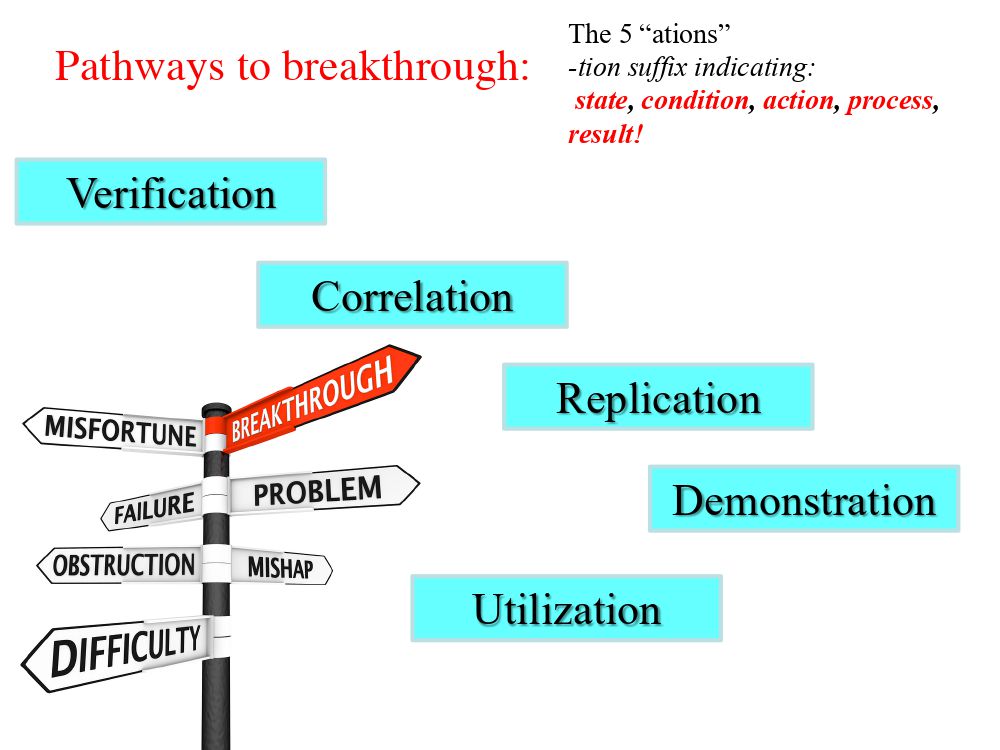
[spacer height=”10px”]
my five “tions”: 09:50 verification, correlation, replication, 09:53 demonstration, utilization — and these 09:55 don’t have to be sequential.
[spacer height=”10px”]
I submit to 10:00 you that the first verification has 10:02 already happened. it happened, 1991, 1992.
[spacer height=”10px”]
Slide7
[spacer height=”10px”]
10:10 I’ll give you some backup for that 10:13 claim in a following slide, but at ICCF-20, 10:17 which I didn’t attend — very very sad 10:20 not to have attended, the first one I 10:21 didn’t attend — but Matt’s terrific. in 10:24 my name, [he] charged the community with a set 10:32 of what I saw as the the problems that 10:35 we were having.
[spacer height=”10px”]
self-censorship 10:39 — we seemed to be a little timid. 10:45 I wonder if we’re not concealing and 10:50 hiding our research for fear of 10:54 disturbing angry large people, 10:58 who might cause us harm, 11:00 financially or otherwise.
[spacer height=”10px”]
are we guarding our 11:04 secrets for fear that others 11:06 might take credit?
[spacer height=”10px”]
and, yes. the answer is 11:09 yes, and every one of you researchers is 11:11 holding something back, because you don’t 11:13 want to give it up.
[spacer height=”10px”]
you don’t want 11:15 somebody else to take it and run with it 11:17 faster, than you’re running with it
[spacer height=”10px”]
. 11:19 but, however, anyone that 11:22 that believes that we’re working on a 11:24 problem that has the potential to 11:26 relieve mankind’s primary problem. our 11:29 primary problem is where are we going to 11:31 get our energy from in the future, 11:33 preferably without further messing up 11:35 the planet.
[spacer height=”10px”]
you believe that. you 11:39 you must collaborate, cooperate, 11:42 communicate.
[spacer height=”10px”]
now, I’ve spent a career in 11:47 confidential research. I understand the 11:49 problem, but I’m here, now, free to 11:55 do so, to exhort a much higher level of 11:59 collaboration and cooperation and 12:01 communication.
[spacer height=”10px”]
we communicate poorly our 12:06 publication record is not very good, and 12:09 not very well codified.
[spacer height=”10px”]
I want to call 12:12 attention to two people who I think have 12:14 done a very large amount to reverse that. 12:19 I see them right here in front of me 12:21 Jed Rothwell and his website is a 12:25 marvelous resource.
[spacer height=”10px”]
when I left SRI, I 12:28 threw away six dumpsters worth of stuff.
[spacer height=”10px”]
12:33 my library in New Zealand has not 12:38 even been built, so I have no access to a 12:41 lot of the material.
[spacer height=”10px”]
I can go on Jed’s site, 12:43 and pull down my own papers, which is 12:45 just a wonderful, wonderful tool.
[spacer height=”10px”]
[applause]
[spacer height=”10px”]
and 12:52 and Jean-Paul [Biberian]‘s stewardship of the 12:58 journal, which is apparently getting 13:01 increasing submissions, and the 13:03 quality is increasing. thank you, Jean-Paul.
[spacer height=”10px”]
[applause]
[spacer height=”10px”]
13:05 but our communication record is bad. 13:14
[spacer height=”10px”]
this failure is both accidental and 13:20 deliberate. we are concealing, you are 13:25 concealing, I am concealing, in fact.
[spacer height=”10px”]
I am 13:27 concealing things from you, because I’ve 13:30 signed my life away on a piece of paper.
[spacer height=”10px”]
13:33 know that I’m not at SRI, I don’t 13:37 have institutional lawyers to back me up, 13:39 so I have to be even more careful about 13:41 whose secrets I don’t give away.
[spacer height=”10px”]
but 13:47 there’s also been a enormous amount of 13:49 repetition, and I hit on this yesterday. 13:52 we’ve discovered the same thing several 13:55 times over .
[spacer height=”10px”]
sometimes because it’s been 13:58 concealed but sometimes because it 14:01 wasn’t read. It was stated orally in 14:06 presentations, conference proceedings, and 14:10 journal publications, and several 14:14 things which I knew very well, and spoke 14:17 about in 1990 have been rediscovered two 14:22 or three times later by research groups 14:24 at huge expense of effort and labor and 14:28 time and skill.
[spacer height=”10px”]
the literature is 14:32 not in the best possible shape, but 14:34 there is a literature, and there is much 14:37 good work in it, it really needs to 14:39 be studied better.
[spacer height=”10px”]
Slide8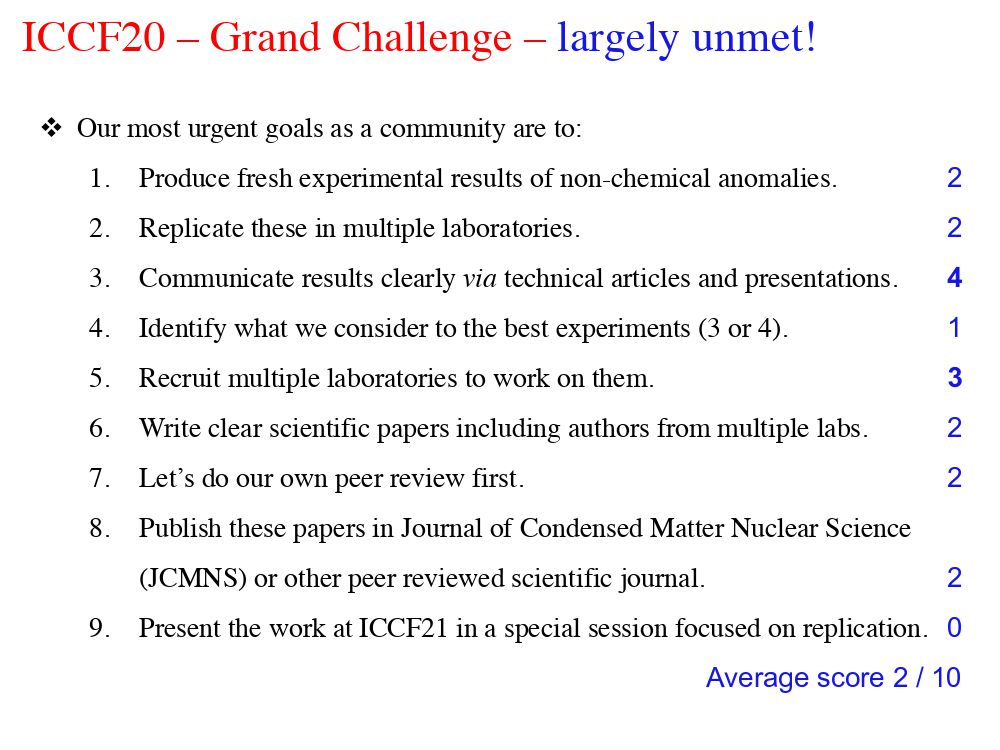
[spacer height=”10px”]
so what Matt said — I’ll 14:47 blame it on Matt — at ICCG-20 was a 14:52 grand challenge, and what I said through 14:55 Matt, was that I would come here and I 14:57 would rank the community against its 15:01 success against these 15:03 objectives.
[spacer height=”10px”]
and the numbers on the right 15:07 in blue are my ranking on, out of ten, of how 15:12 well we’ve achieved in these various 15:15 things.
[spacer height=”10px”]
produce fresh experimental 15:18 results of non chemical anomalies. I’m 15:24 embarrassed 15:25 frequently to give presentations and go 15:29 back to data that I measured in 1990, 15:34 1991. there was a huge flux of new 15:40 information came out, but fresh 15:43 things are not really happening at the 15:45 rate that I would like to see. I don’t 15:48 want to use me as a source. I want to use 15:51 you guys, in your research 15:54 as a source of moving forwards.
[spacer height=”10px”]
new 16:00 anomalies need to be seen observed, 16:02 measured, and replicated in multiple 16:05 laboratories.
[spacer height=”10px”]
these results need to be 16:09 communicated clearly, technical articles.
[spacer height=”10px”]
16:12 JCMNS is fine. if we can do it other 16:15 places, that’s good too, and I would like 16:18 to see us as a group, as a community, 16:21 identify the three or four best 16:23 experiments, and organize some sort of 16:28 multi-laboratory efforts to replicate it. 16:30 write some papers, peer review.
[spacer height=”10px”]
but as you 16:35 see my scale, here only communication 16:38 sort-of gets a four, everything else is 16:42 one, two, or zero. 16:49 we have not done a good job of any 16:53 of the things. now it’s my challenge, so 16:55 it’s not up to you to do 16:58 it’s up to me to somehow stimulate 17:01 this.
[spacer height=”10px”]
but we just didn’t do a very good 17:03 job against the challenges that Matt set 17:06 or I set through Matt.
[spacer height=”10px”]
Slide9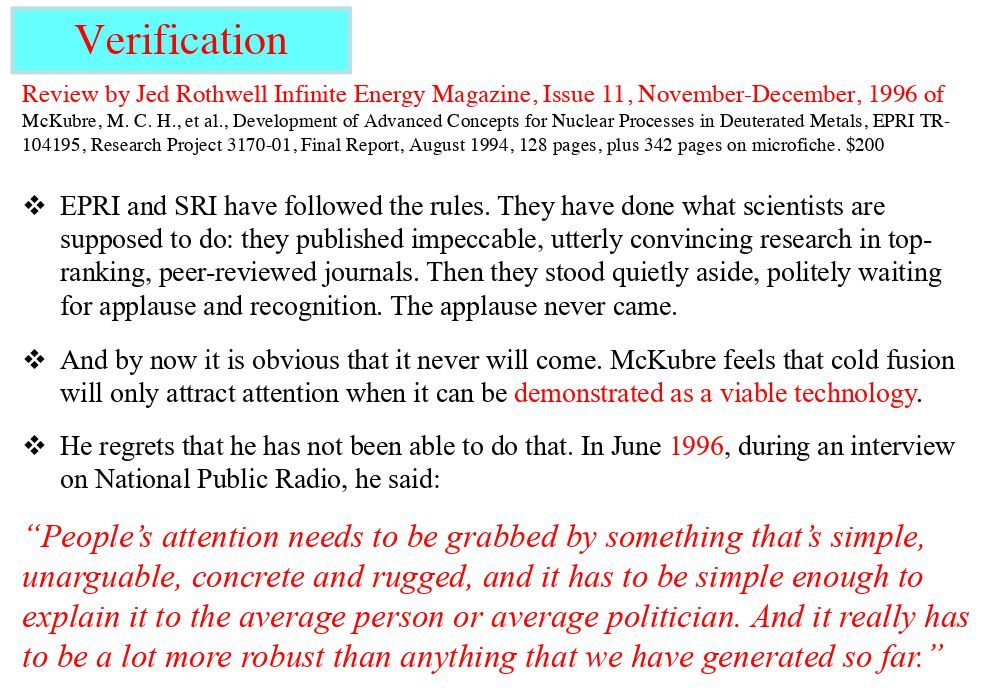
[spacer height=”10px”]
17:12 how are we doing on these “tions,” you know, 17:16 verification, correlation replication 17:18 whatever.
[spacer height=”10px”]
verification I’d say it’s done. 17:23 in preparing this I went back to a 17:26 review that Jed Rothwell had written in 1996, 17:31 about the first EPRI report, which 17:36 was published in 1994, of work that was 17:40 all completed by 1992. 17:43 I’ll read Jed’s words — these are Jed’s 17:46 words, not mine — 17:47 EPRI and SRI, followed the rules, 17:49 they’ve done what scientists are supposed 17:51 to do they published impeccable — Thank 17:53 You, Jed — utterly convincing research, in 17:56 top-ranking peer-reviewed journals, then 17:59 they stood quietly aside, politely 18:02 waiting for applause and recognition. 18:04 — Jed got that wrong, I didn’t stand 18:07 politely aside — and by now it’s obvious 18:12 that it will never come. 18:13 McKubre feels that cold fusion will only 18:15 attract attention when it can be 18:17 demonstrated as a viable technology. 18:20 those words in red came as a shock to 18:23 me, because I’ve started saying that 18:25 again. I didn’t realize I was so smart in 18:28 1996. smart and sad actually, this 18:32 shouldn’t be the way that science 18:35 progresses.
[spacer height=”10px”]
but it I think it has to be.
[spacer height=”10px”]
18:38 in this last half of the talk is, how we 18:40 might do this. and Jed quotes me 18:47 in a radio interview, now these are my 18:49 words, people’s attention need to be 18:50 grabbed by something that’s simple, 18:53 unarguable, concrete and rugged, and it 18:56 has to be simple enough to explain to 18:58 the average person or average politician, 19:01 who’s slightly lower level [laughter], and it really 19:06 has to be a lot more robust than 19:08 anything that we’ve generated so far so. 19:10 I recognized where we needed to go and 19:13 that we weren’t there.
[spacer height=”10px”]
Slide10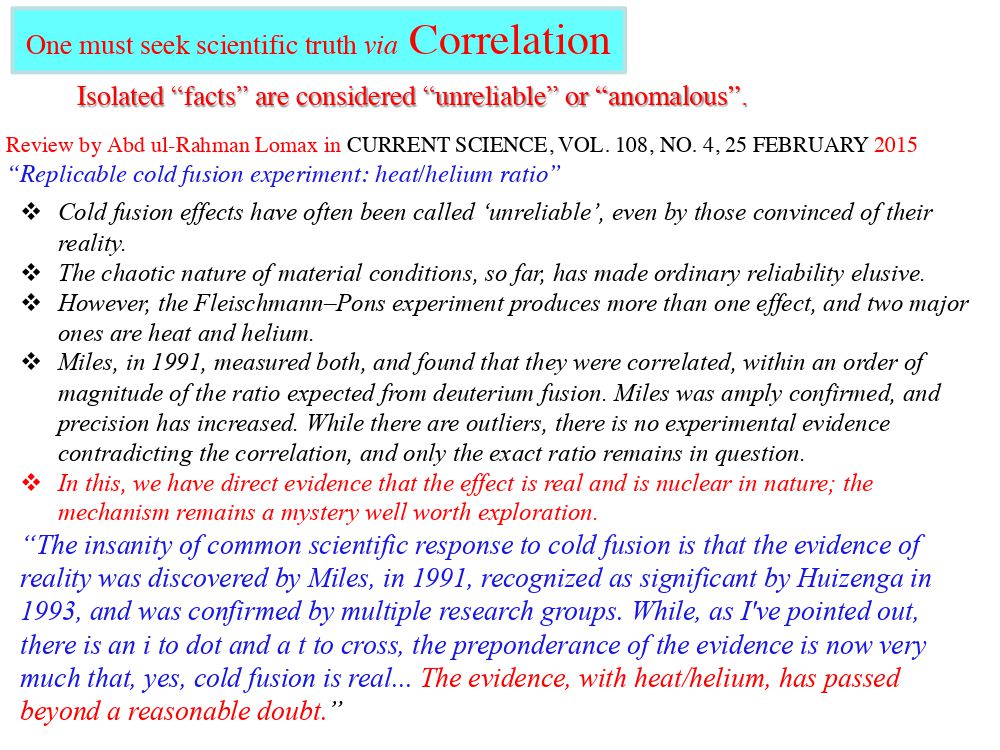
[spacer height=”10px”]
now I’m gonna try 19:15 and take you in a pathway that might 19:18 allow us to get there. 19:22 we covered verification I 19:25 say it’s done I’d say — Jed says it’s done.
[spacer height=”10px”]
19:29 Jed says that SRI-EPRI work provided 19:32 the verification in 1992. Mel Miles, heat-helium 19:38 correlation, did that job too.
[spacer height=”10px”]
19:42 that verified the nuclear basis of a 19:46 heat effect all done. 1992. here we are 19:53 20-something years later and we’re still 19:56 talking about it.
[spacer height=”10px”]
19:59 you can see scientific truth through 20:02 correlation here. I’m quoting Abd Lomax 20:06 in the issue of Current Science that 20:10 Srinavasan and Meulenberg very nicely 20:14 put together. Abd focuses attention on 20:22 correlation as having the power to 20:26 overcome potential systemic errors in 20:30 single measurements.
[spacer height=”10px”]
if measurements are 20:32 correlated, then this possibility of 20:35 systemic error becomes much, much less.
[spacer height=”10px”]
20:38 quoting Abd, now: coldfusion 20:40 effects have often been called 20:41 ‘unreliable,’ even by those convinced of 20:45 their reality.
[spacer height=”10px”]
in this community, as close 20:47 as it is, and as is filled with as 20:50 nice a people, as it is, we still find 20:55 charges: “my work isn’t unreliable, my work 21:00 could be heat, your work is unreliable. I 21:04 don’t believe in the tritium, or I don’t 21:05 believe in the helium.
[spacer height=”10px”]
so you know … but 21:09 that’s that’s good 21:10 that’s a good thing, as long as it has a 21:11 scientific basis.
[spacer height=”10px”]
Abd again: the chaotic 21:15 nature of material conditions so far has 21:18 made ordinary reliability elusive. 21:21 Fleischmann Pons Heat Effect produces 21:24 more than one effect, two being heat and 21:28 helium. 1991, Mel measured both, found they 21:32 were correlated 21:34 and this was replicated well.
[spacer height=”10px”]
21:44 the the statistical chance of Mel’s 21:48 correlation between heat observation and 21:51 helium observation is nearly a million 21:54 to one.
[spacer height=”10px”]
that this was done 21:58 you know stochastically. the insanity of 22:02 common scientific response to cold 22:03 fusion is that the evidence of reality 22:06 was discovered by Miles in 1991, 22:09 recognized as significant by Huizenga in 22:12 1993, and was confirmed by multiple 22:15 research groups. this is 22:21 Abd’s words. as pointed out there 22:23 while there is an i to dot and a t to cross, the 22:26 preponderance of evidence is now very 22:29 much that cold fusion is real the 22:33 evidence of heat and helium has passed 22:34 beyond a reasonable doubt.
[spacer height=”10px”]
so 22:38 verification correlation, we’re good with 22:41 those “tions.”
[spacer height=”10px”]
Slide11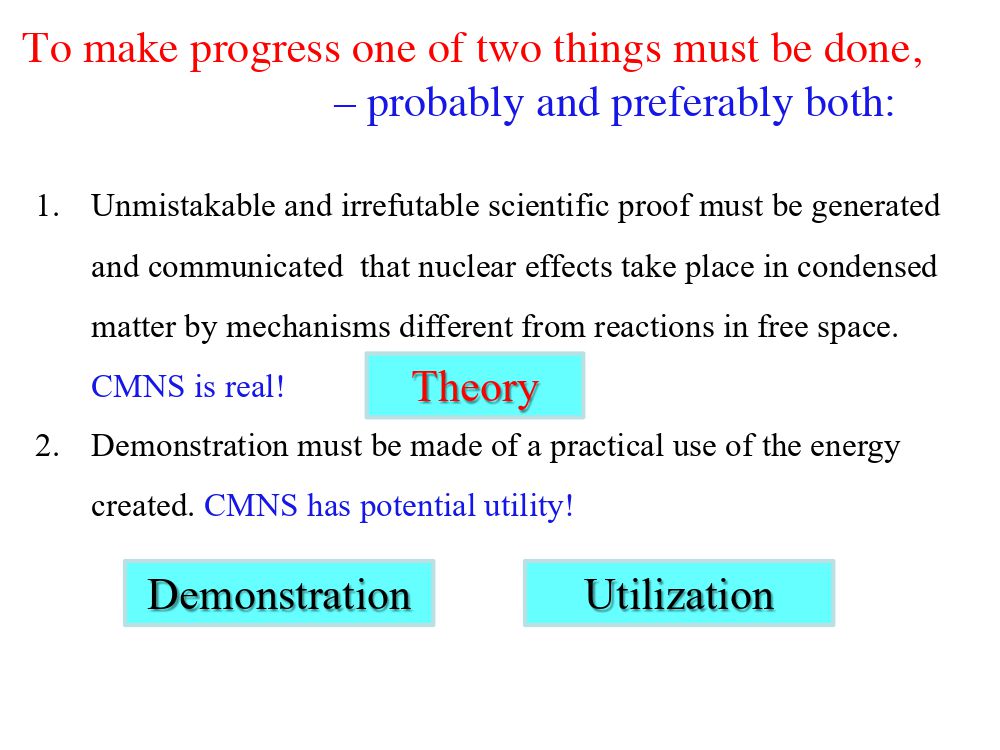
[spacer height=”10px”]
how about the rest?
[spacer height=”10px”]
to make 22:48 progress, I claim that one of two things 22:52 needs to be done, preferably both. we need 22:56 an unmistakeable and irrefutable 22:58 scientific proof that nuclear effects 23:01 take place in condensed matter, by means, 23:04 at rates, with products different from 23:09 similar reactions occurring in free space.
[spacer height=”10px”]
23:12 that is, condensed matter nucleus science 23:16 is a real thing. the fact that it occurs 23:19 in a lattice is significant. as Julian 23:22 Schwinger, the prince of condensed matter 23:25 nuclear physics, said very, very early on 23:29 in 1989.
[spacer height=”10px”]
theory is going to help us here 23:35 and Peter Hagelstein presented 23:38 interesting new concepts. yes, I’ve been 23:41 listening to Peter so long that I have 23:44 his voice in my head at night. I can see 23:48 his equations.
[spacer height=”10px”]
that theory is coming 23:55 along as I’ve often said the problem 23:58 with theory isn’t theorists it’s 23:59 experimentalists. we haven’t given the 24:02 theorists sufficient ammunition to fuel 24:05 their imagination.
[spacer height=”10px”]
point 2. 24:14 demonstration must be made of a 24:16 practical use of the energy created. 24:19 when I wrote those words I didn’t 24:23 realize that I’d already said them in 24:24 1996.
[spacer height=”10px”]
Slide12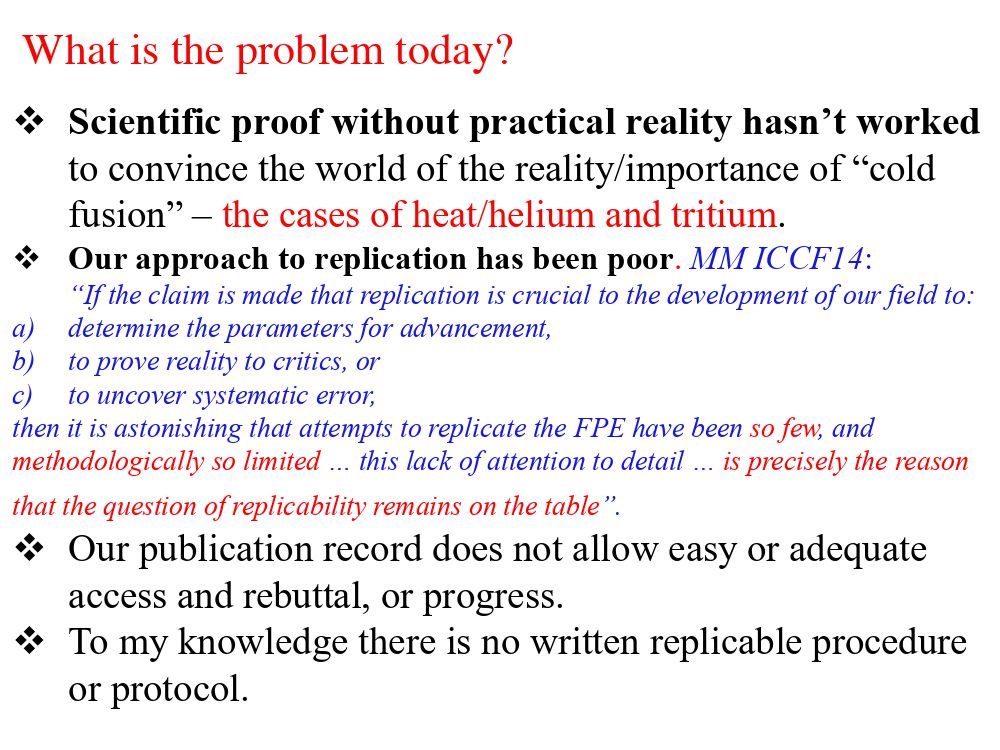
[spacer height=”10px”]
so how do we do this 24:29 demonstration and utilization? what is 24:33 the problem today? 24:35 scientific proof without practical 24:37 reality hasn’t worked to convince the 24:40 world.
[spacer height=”10px”]
I’ve made the arguments that we 24:43 have the scientific proof: we have heat [and] 24:44 helium correlated. we have tritium, and 24:52 the tritium evidence came to us already 24:55 pre-replicated the work of Claytor, 25:00 Storms, Srinivasan, and Bockris, four 25:06 highly talented individuals, working in 25:08 highly competent research groups, told us 25:11 that these experiments sometimes produced 25:15 tritium. a single atom of tritium 25:18 produced in any of our experiments is 25:20 proof that CMNS is real. that didn’t 25:26 work.
[spacer height=”10px”]
25:28 our approach to replication has been 25:31 poor. at ICCF-14 25:37 (they will remember when that was, but it 25:38 was a while ago) I made the claim, 25:42 well, the charge, that if the claim is 25:45 made that replication is crucial to the 25:48 development of our field, to determine 25:50 the parameters for advancement, 25:52 to prove reality to critics, or to uncover 25:56 systematic error, then it is astonishing 25:58 that attempts to replicate the 26:00 Fleischmann Pons Effect have been so few, 26:03 methodologically so limited.
[spacer height=”10px”]
this lack of 26:06 attention to detail is precisely the 26:09 reason that replicability remains on the 26:12 table. our efforts at replication 26:16 have been shocking. we’re all so 26:23 fertile in our experimental imagination, 26:27 that given the chance to replicate, we 26:29 can’t avoid the impulse to improve.
[spacer height=”10px”]
there 26:34 have been very few legitimate, honest, 26:38 direct engineering replications of any 26:43 of the effects that we’ve talked about. 26:45 one that was done, again Jean-Paul was 26:48 involved, and Longchamps, a direct 26:53 engineering replication of the 26:55 Fleischmann-Pons high-temperature heat-producing 26:59 experiments.
[spacer height=”10px”]
the conclusions of 27:02 the authors of the paper, that came out 27:05 of that replication, were that Martin’s 27:07 right. what he said is right 27:09 it’s true, it’s there, it’s real.
[spacer height=”10px”]
I’ve 27:13 already spoken about our publication 27:15 record. basically it’s not easy for 27:18 somebody who wants to enter into 27:20 the field to go to any place and 27:23 find a set of papers that they 27:27 should read in order to 27:30 prepare themselves to enter the field 27:32 experimentally. it needs to be better 27:35 codified and I think in time that will 27:37 be.
[spacer height=”10px”]
to my knowledge there is no 27:41 written 27:44 replicable procedure or 27:47 protocol. nobody’s written down on a 27:49 piece of paper a procedure that, if 27:51 followed, will always work.
[spacer height=”10px”]
Slide13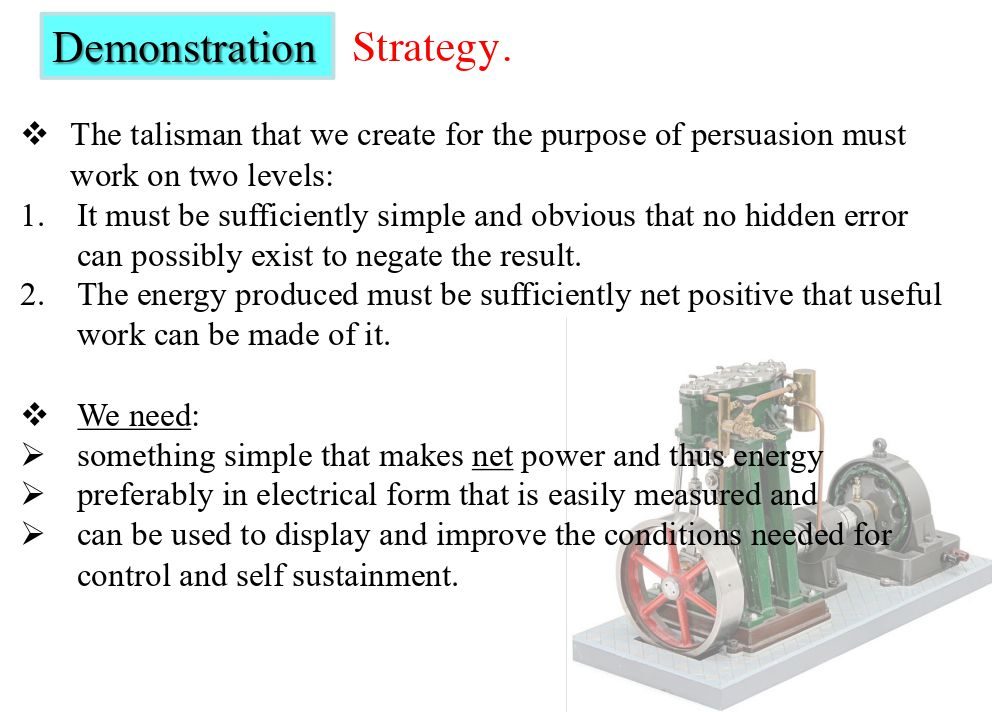
[spacer height=”10px”]
27:57 so I want to demonstrate, I want to do 28:00 something simpler than a steam engine, 28:03 connected to a generator, the generator 28:06 feeding the the dumbed-down 28:10 at steam engine providing its ignition 28:11 initiation and control. make the thing a 28:16 closed loop, and have some power left 28:17 over to do something. the talisman that 28:20 we create for that purpose has got to 28:23 work on two levels: be sufficiently 28:25 simple and obvious that no hidden error 28:27 can possibly exist to negate the result. 28:31 we’re gonna have to communicate this to 28:35 people who are going to be bright, 28:36 they’re going to be possibly technical 28:39 or somewhat technical, but they’re 28:41 not going to be specialists.
[spacer height=”10px”]
the 28:44 individual that we’re trying to 28:45 communicate with will hire himself a 28:47 physics professor to do due diligence as 28:52 a consultant, and I’ve been a consultant’
[spacer height=”10px”]
28:55 you cannot make mistakes as 29:00 a consultant. you can’t make an error. if 29:03 you do that, you don’t get any more 29:04 consulting jobs, if you’re known to be a 29:06 bumbler.
[spacer height=”10px”]
so the physics professor is 29:09 gonna find some fault, some 29:12 reason it’s not true, or some reason to 29:16 to cage his statements.
[spacer height=”10px”]
we had an 29:23 experience of that at EPRI. the work at 29:26 SRI, we were confident of it, happy with 29:29 it, realized we weren’t breaking through, 29:31 so we brought in two senior people, Dick 29:35 Garwin and Nate Lewis, to review the 29:39 work at SRI , to kick the experiments 29:43 poke ’em, and find out you know what the 29:45 what the problem was, and write a report 29:46 thereafter. we did this twice actually. 29:50 the other group I called the four B’s. Allen Bard 29:53 was involved [YT: how it burned down] 29:55 basically that these guys come in, they 29:59 write report, we let them see 30:02 everything. experiments, data, direct 30:05 access to whatever they wanted. the 30:07 reports always say the same 30:09 these: are good people doing good 30:11 experiments. we couldn’t find any error, 30:15 but it’s a complicated experiment and 30:18 there might be one.
[spacer height=”10px”]
[laughter]
[spacer height=”10px”]
it’s actually worse 30:22 than having no report.
[spacer height=”10px”]
and I say that 30:28 we’re going to need to make the energy 30:30 . . . we should, this is just a strategy 30:33 here . . . the energy produced must be 30:35 sufficiently net positive that useful 30:37 work can be made of it.
[spacer height=”10px”]
Slide14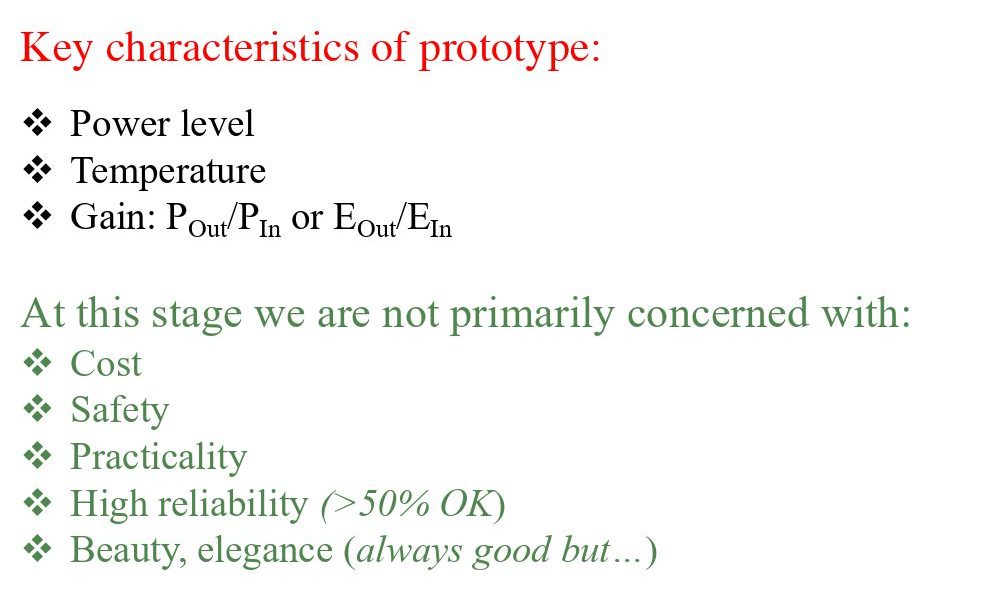
[spacer height=”10px”]
what chances do 30:46 we have of doing that?
[spacer height=”10px”]
what would we need 30:48 to do? what are the characteristics of a 30:50 prototype?
[spacer height=”10px”]
what would be the power 30:52 level? what temperature? what gain? 30:55 output power over input power, output 30:57 energy over input energy.
[spacer height=”10px”]
at this 30:59 stage we’re not concerned primarily with 31:01 cost. I don’t care how much it costs. 31:04 safety, I shouldn’t say that . . . but we 31:07 can put it behind whatever barrier you 31:09 want.
[spacer height=”10px”]
I know we’re not going to let this 31:11 loose on civilian population, so we can 31:14 maintain safety in the laboratory.
[spacer height=”10px”]
I 31:16 don’t care if it’s practical and don’t care if 31:19 it’s reliable. I’d like it to do what I 31:22 say it’s going to do, more than half the 31:26 time. 50% would be enough. it 31:29 doesn’t have to be beautiful or elegant, 31:31 that’s always good, but this is not 31:33 something that we need to concern 31:34 ourselves with right now.
[spacer height=”10px”]
Slide15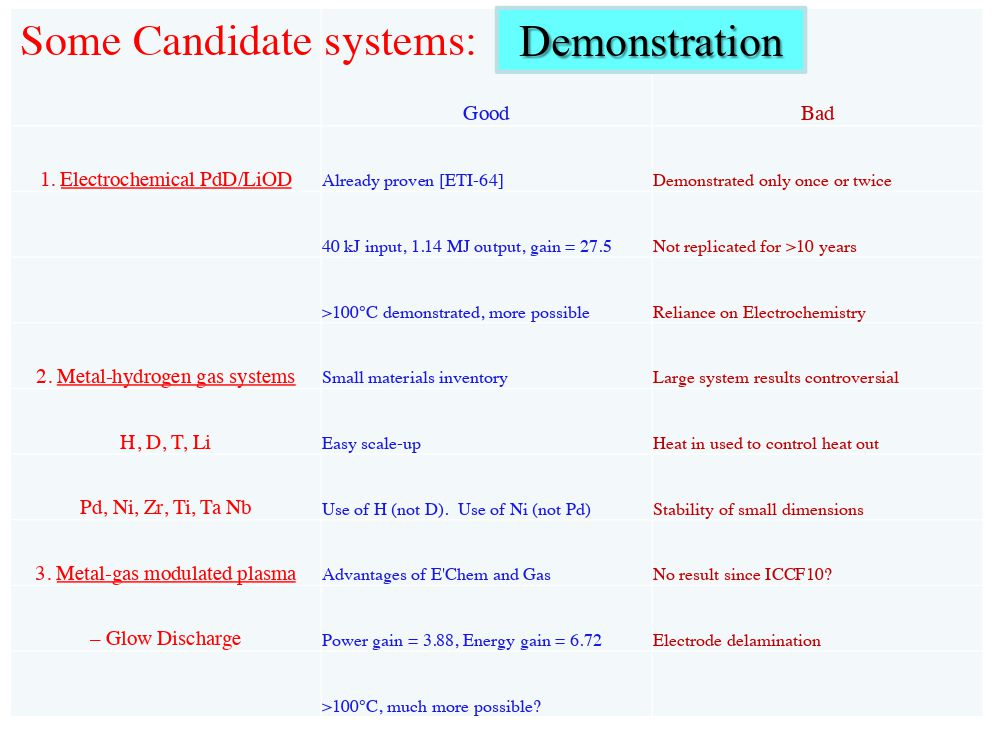
[spacer height=”10px”]
there are some 31:38 candidate systems with which I’m 31:40 familiar. I’m sorry for the 31:42 small words.
[spacer height=”10px”]
there are three candidate 31:47 systems that I have direct personal 31:49 experience with. the second one, not so 31:52 much 31:53 but the electrochemical PdD LiOD 31:56 experiment is the one I have 90 percent 31:58 of my familiarity with.
[spacer height=”10px”]
and this is the 32:01 — you know — I’m looking for my keys under 32:04 the street light. this is my street light, 32:06 the electrochemical PdLiOD experiment. 32:10 I agree, Jean-Paul yesterday said that 32:16 electrochemistry is too hard, right. we 32:19 can’t rely on electrochemistry 32:21 to take us to 32:22 an object that we can 32:26 unleash on a civilian population, 32:29 it’s too hard.
[spacer height=”10px”]
it is too hard, he’s right. 32:32 but the good news about the 32:35 electrochemical experiment is: it has 32:38 already demonstrated all of the 32:40 characteristics that we need for my 32:42 prototype. it’s already been done. it was 32:45 done with by Energetic Technologies, ETI 32:49 in their famous experiment ETI-64 which 32:53 I’ve spoken about very many times. 32:56 I think Dave put the slide up 32:58 yesterday. 40 kilojoules of input, 1.14 33:02 mega joules of output. gain of 27.5, 33:06 and that’s an important number, and it 33:09 boiled water.
[spacer height=”10px”]
so we’ve got 100 degrees C 33:11 out of it. it’s got some bad things 33:14 associated with it: it was only demonstrated 33:16 once or twice, and hasn’t been replicated 33:18 for the last 10 years, and this reliance 33:21 on dirty dangerous electrochemistry. . . .
[spacer height=”10px”]
33:25 there are other systems I’m not going to 33:27 go through them time, is ticking down, but 33:30 you could do this in the metal gas 33:33 hydrogen gas system. my guess is if this 33:36 thing ever becomes widespread and 33:39 large-scale it will be a metal gas 33:41 system and there are very good reasons 33:43 for that, cost being one of them, 33:47 materials degradation being another but 33:49 the there’s a little bit of a pall over 33:53 the nickel hydrogen stuff right now.
[spacer height=”10px”]
33:58 I’m not convinced either way, I 34:03 don’t know, because I haven’t seen the 34:05 effect in my own laboratory with my own 34:07 eyes. I therefore don’t believe 34:09 immediately falling into the region of 34:14 people that I criticized before, 34:18 but 34:19 I’m just going to focus on this first 34:21 one.
[spacer height=”10px”]
Slide16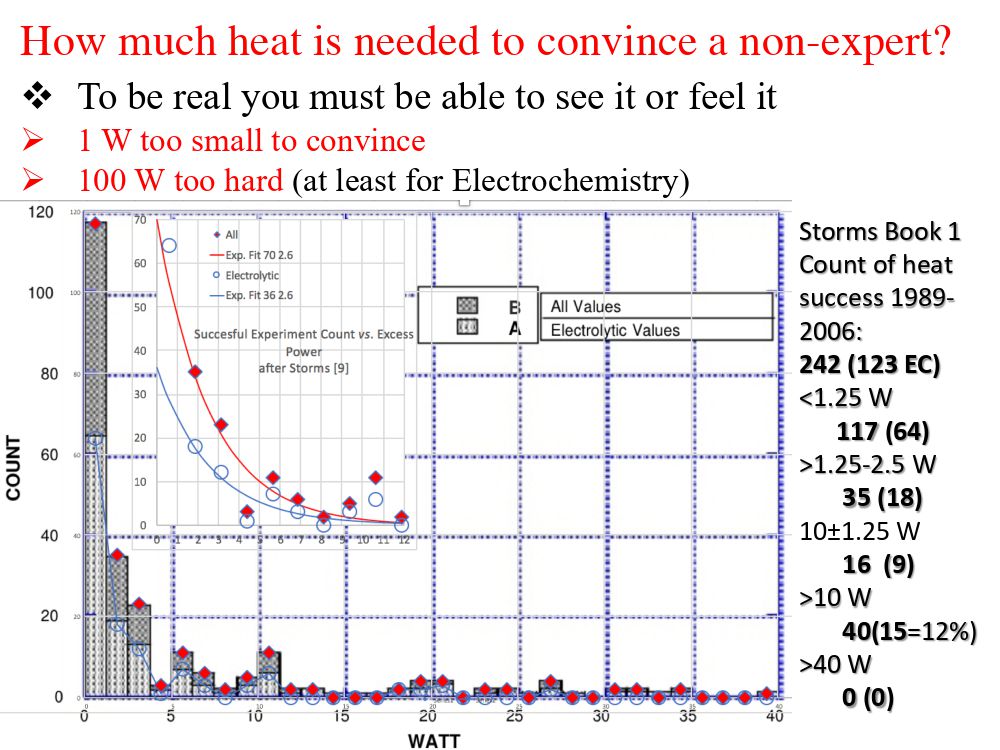
[spacer height=”10px”]
how are we gonna do that, if the 34:24 charge is “demonstration prototype”?
[spacer height=”10px”]
34:28 electrochemical system: how much heat do 34:32 we need? well we’re 34:34 like all simians where touch-and-see 34:39 things I believe that to be real .
[spacer height=”10px”]
you 34:41 need to be able to see it or feel it. 34:44 numbers are not good enough especially 34:47 where heat is concerned, because heat is 34:48 ephemeral, unless you can do work with it 34:51 I say that one watt is too small to 34:54 convince, and 100 watts is too hard, in 34:57 least for the electrochemistry, and 34:59 the argument for that was persuasively 35:02 made by Ed Storms in his first book. He 35:06 reviewed 242 successful heat producing 35:12 experiments, and you can see the 35:14 histogram of his results, and his 35:17 original plot is the the bar 35:20 graph, and I’ve superimposed some 35:24 exponential curves on it just to show 35:26 how the trends go, but basically half of 35:30 the successful experiments were less 35:32 than 1.25 watts.
[spacer height=”10px”]
these are too 35:36 small. as you go up there’s some power in 35:40 the tail, and if you look, 35:44 between 1.25 and 2.5 watts — which i think 35:47 still is too small — 35:48 thirty-five experiments, but greater than 35:51 10 watts — I’m gonna say 10 watts is 35:54 enough. 40 experiments, 15 electrochemical 36:00 experiments, 12% of the electrochemical 36:03 experiments fall into this region 36:06 greater than 10 watts.
[spacer height=”10px”]
so it has been done 36:10 we might have a 36:12 shot at producing a 10 watt demonstrator, 36:17 but there’s a savage beast of Sadi Carnot 36:24 comes to beat us down.
[spacer height=”10px”]
Slide17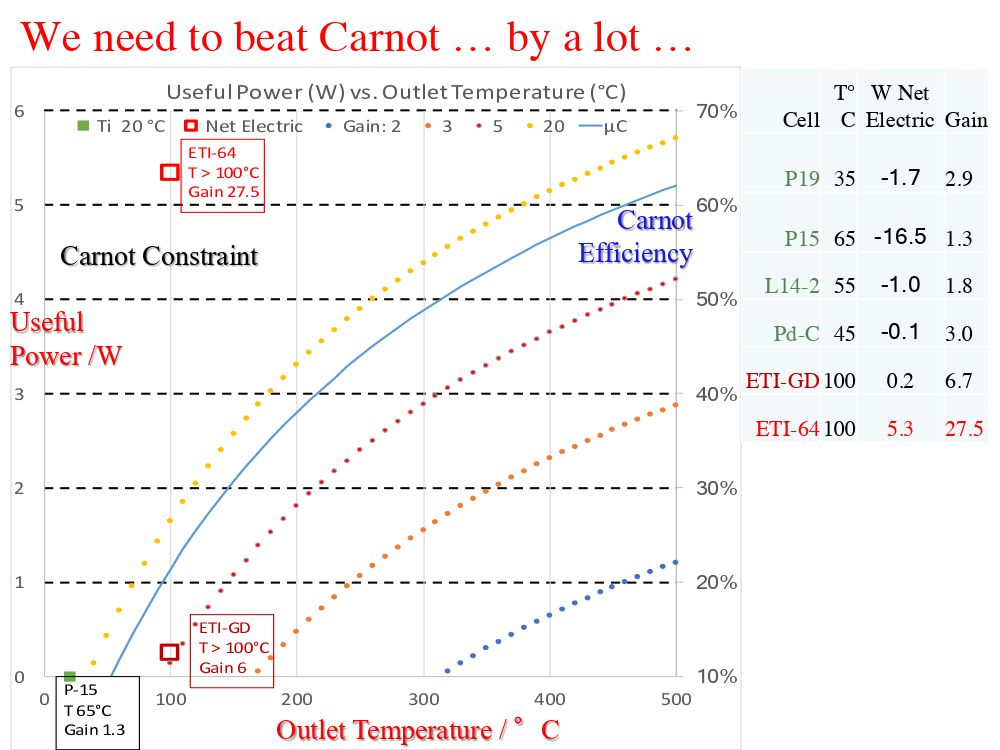
[spacer height=”10px”]
if we had 10 watts 36:29 of heat how much could we demonstrate?
[spacer height=”10px”]
36:32 how much power could we put into the 36:34 system to maintain that operation, and 36:37 how much could we get out for 36:40 show.
[spacer height=”10px”]
the blue solid line here is the 36:45 Carnot efficiency 36:47 with a thermal rejection temperature of 20 36:50 degrees, so by the time you get to 500 36:53 degrees your efficiency is 60 odd 36:55 percent.
[spacer height=”10px”]
but remember, the 36:59 Carnot limit is a limit that can’t 37:01 be reached, and it can’t even be 37:03 approached, and it’s harder to approach 37:05 it as you get lower in temperature so 37:08 we’re gonna have to beat that limit by a 37:10 lot.
[spacer height=”10px”]
I’ve plotted some points on here. 37:14 the dotted curves are various 37:17 calculations based upon the gain. 37:19 how much power we can use for show 37:23 is a function of how much power we need 37:26 to keep the beast running.
[spacer height=”10px”]
so but if we 37:31 had ETI-64 . . . you find it, it’s on 37:40 the hundred degree line. the point up 37:42 there is that ETI-64 result. if we 37:45 had that result, pushed it through a 37:48 thermal heat-to-electrical 37:52 conversion, fed the electricity needed for 37:56 the experiment, we would have five watts 37:58 left over for our demonstrator.
[spacer height=”10px”]
38:02 Dennis 38:03 Craven’s could use it to charge up his 38:06 electrified Model A or Dave could use it 38:09 or Steve could use it to power their 38:12 cell phones.
[spacer height=”10px”]
at five watts to 38:14 demonstrate a flashing light or ring a 38:15 bell would be convincing. it’s a toy but 38:19 it would be convincing. down the bottom 38:22 is the other ETI experiment, a glow 38:27 discharge experiment. I’ve put it at a 38:29 hundred degrees but 38:31 it’s a plasma, so that thing could 38:33 actually be sitting up at 500 degrees 38:37 and that efficiency would then be more 38:39 than 50% .
[spacer height=”10px”]
so you get four watts out of 38:41 that. so either of the ETI experiments 38:44 would serve the purposes of my 38:45 demonstrator.
[spacer height=”10px”]
my best results at SRI are 38:52 the green points which sort of fall on 38:54 the line
[spacer height=”10px”]
Slide18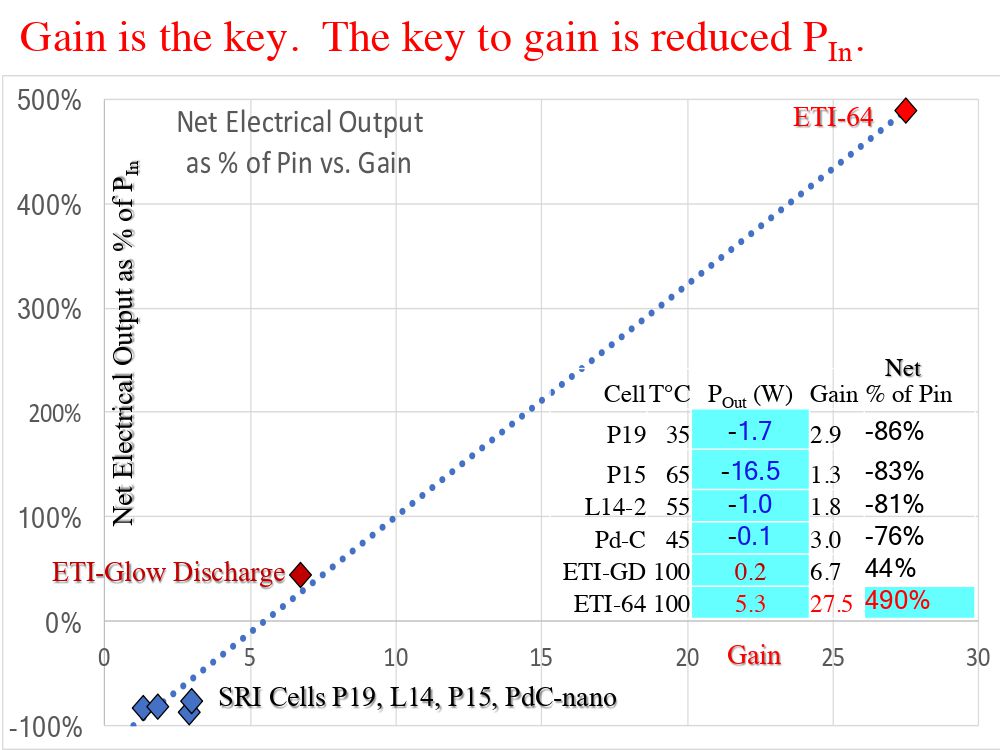
[spacer height=”10px”]
and I split them out here. if 38:57 you plot 38:59 gain versus how much power you’re gonna 39:02 get, the thermal efficiency five hundred 39:04 percent thermal efficiencies you get — the 39:10 percentage of input plus so the ETI 39:13 system sitting at the star [unintelligible] 39:16 the star performer is up 39:19 here at five hundred percent. the SRI 39:22 cells, the best of them, the ones I was 39:24 most proud of, will fall below the line. 39:27 all of them needed more power to operate 39:30 then a thermal to electric conversion 39:35 would supply, even at the Carnot limit, 39:38 which you can’t achieve, so to be kind 39:44 to SRI and me our experiments were not 39:48 intended to be demonstrators, but they 39:50 could not have performed as such.
[spacer height=”10px”]
Slide19
[spacer height=”10px”]
39:52 conclusions.
[spacer height=”10px”]
40:00 reasonable pathways exist to explore or 40:04 exploit the Fleischmann Pons Heat 40:07 Effect.
[spacer height=”10px”]
the pathways have got to involve 40:10 these five “tions:: verification, 40:13 correlation, replication, demonstration, 40:17 utilization.
[spacer height=”10px”]
for wide acceptance, 40:22 demonstration must be made of a 40:25 practical use of this energy. this is my 40:28 assertion. just me saying this, this might 40:31 not be true, there may be other pathways, 40:32 but since I said it in 1996 and forgot 40:36 it, and so I’m saying it again now, it might 40:37 be true. I thought of it 40:39 twice.
[spacer height=”10px”]
we need to identify a 40:43 demonstration prototype.
[spacer height=”10px”]
electrochemical 40:47 methods with which I am most familiar 40:50 could work for this demonstrator. they 40:55 have worked, rarely but if we could 40:58 uncover the circumstances and conditions 41:00 under which these experiments did work, 41:02 and do them better, we could do it by 41:06 electrochemistry. I said before, and I 41:08 agree with Jean-Paul I doubt that 41:12 an electrochemical system can be made 41:16 widely available to the public it’s too 41:19 challenging, it’s it’s too hair-trigger 41:22 on small concentrations of impurities, 41:26 and electrochemistry is a tough game. 41:29 there are very few people that have 41:31 succeeded who weren’t well-trained 41:34 electrochemists, a few who are very 41:35 lucky. Dennis 41:38 Cravens is not an electrochemist but 41:40 at ICCF-4 in Maui in 1993, at the 41:47 end of the session, Martin Fleischmann 41:49 got up and complimented Dennis Cravens 41:53 for his understanding of the system. What 41:56 Dennis had figured out what you needed 41:58 to do, how you needed to do it, even why 42:00 you need to do it. he’s 42:02 not an electrochemist, but he’s a great 42:04 tinkerer, he asks great questions, 42:06 annoyingly sometimes.
[spacer height=”10px”]
and you know you 42:13 got to be lucky too. but you’ve got to try, 42:15 to be lucky. operating temperature 42:19 is important. high gain is 42:24 crucial, and gain is more easily affected 42:29 in the denominator than the numerator 42:31 we’re going to need a certain amount of 42:33 power out, but we want to do everything 42:36 we can to make the power in as small as 42:38 possible, so we can get high gain. its 42:40 gain that’s going to allow us to beat 42:42 Carnot. so our goal is to create the heat 42:46 effect at low input power.
[spacer height=”10px”]
Slide20
[spacer height=”10px”]
and that’s 42:51 what I have thank you
List of Slides with links:
Slide1 Technical Perspective
Slide2 Preface, Background
Slide3 Technical contributions, Funding
Slide4 for CMNS to be “anomalous” no more, how do we make it happen?
Slide5 In the face of entrenched cognitive dissonance . . .
Slide6 Verification, Correlation, Replication, Demonstration, Utilization
Slide7 ICCF-20 noted self-censorship, poor communication
Slide8 Grand Challenge, largely unmet
Slide9 Verification, quote Jed Rothwell
Slide10 Correlation, quote Abd ul-Rahman Lomax
Slide11 To make progress . . .
Slide12 What is the problem today?
Slide13 Demonstration strategy
Slide14 Key Characteristics of Prototype
Slide15 Some Candidate Systems
Slide16 How much heat is needed to convince a non-expert?
Slide17 We need to beat Carnot . . . by a lot. . .
Slide18 Gain is the key. The key to gain is reduced PIn.
Slide19 Conclusions
Slide20 Grateful acknowledgment to my esteemed colleagues
